Marriage Pillowe - last phase
Tomorrow, I'll start the final phase of the Marriage Pillowe. Finishing it before Christmas would be a miracle (well, pretty amazing, anyway!) but I think I'll get it done before the end of January. There isn't loads left to do but beginning Friday we have Christmas guests until after New Year's day so I'll have limited time for stitching. There will be stitching time every day, but I'm predicting my progress will be slower. I am so excited to see everyone, you can't imagine! Living far away from family and friends makes each visit super special. This year I'm excited to show them my work space and all the embroidery I've done the past year, live and in person, not on the computer screen!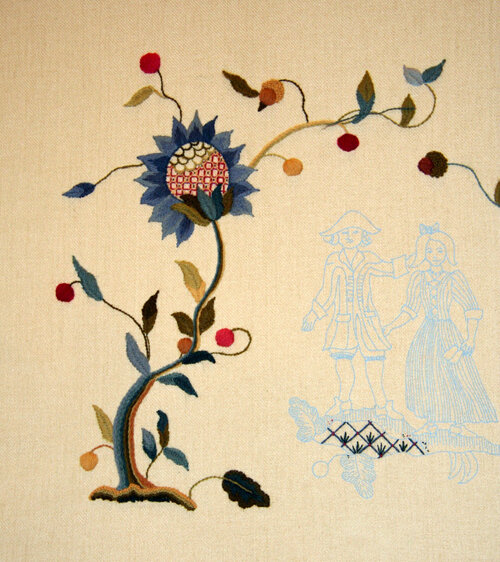 Here's the first side I stitched all finished. I just love the multicolored, thick stem on the flower. Reflecting back on stitching this section I remember being most impressed with the use of double thread and the great texture it gave the piece.The blue flower, with it's long and short shaded petals and the pretty laid and couched work in the middle.
Here's the first side I stitched all finished. I just love the multicolored, thick stem on the flower. Reflecting back on stitching this section I remember being most impressed with the use of double thread and the great texture it gave the piece.The blue flower, with it's long and short shaded petals and the pretty laid and couched work in the middle.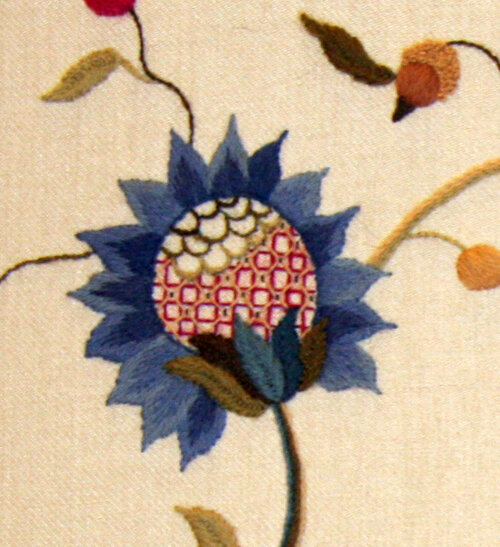 The second section is on the far right of the piece and has two large design elements; the large red flower and the blue and gold leaf at the bottom. It, too, has a thick stem but with fewer colors. The added touch of red on the left side adds depth and is a brilliant use of color for accent.
The second section is on the far right of the piece and has two large design elements; the large red flower and the blue and gold leaf at the bottom. It, too, has a thick stem but with fewer colors. The added touch of red on the left side adds depth and is a brilliant use of color for accent.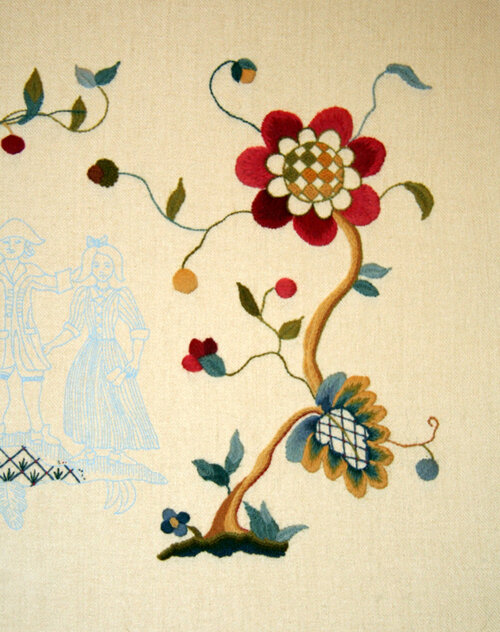 The red flower at the top has long and short shading done in those gorgeous shades of red, with the gold and green French knots in the center. The checkerboard pattern of French knots is so clever.
The red flower at the top has long and short shading done in those gorgeous shades of red, with the gold and green French knots in the center. The checkerboard pattern of French knots is so clever.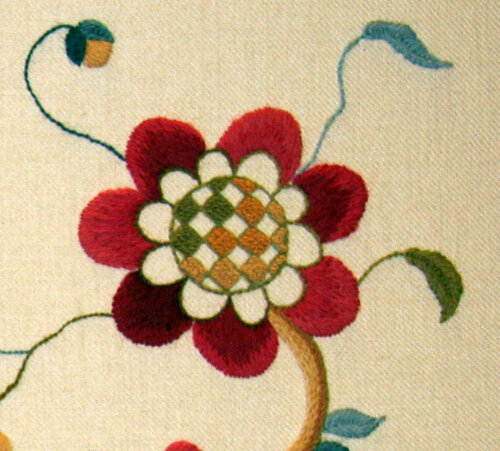 The leaf was a revelation in how to blend colors for beautiful shading. The use of the blue and the gold threads works perfectly and the shading was so much fun to do. It felt like I was stitching the leaves as they changed color.
The leaf was a revelation in how to blend colors for beautiful shading. The use of the blue and the gold threads works perfectly and the shading was so much fun to do. It felt like I was stitching the leaves as they changed color.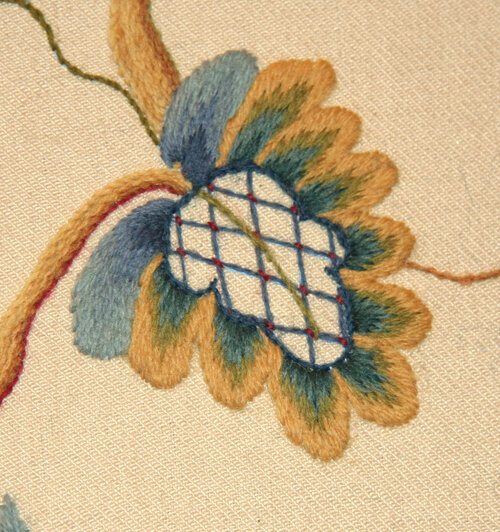 Working one of the Crewel Work Company kits is as close to taking a class with Phillipa Turnbull as you can get without actually being there. The instructions on how to stitch the piece are clean and concise. However, there is an added benefit to working one of the lovely kits: you can learn by observation and analysis.As I worked, I noticed and analyzed what colors she chose to place where in the design. I became aware of the different size of the various elements and how she balanced them throughout the piece. I was aware of her stitch choices and how effective they were for each part of the design. The variation in texture and heaviness or lightness of the design was something to which I paid attention.Artists in the studios of Renaissance painters painted in "the style of" their master as a way to learn the techniques that worked so effectively. Working on one of the Crewel Work Company kits is very much like working in the studio of the master: Phillipa Turnbull. There is so much to learn if we just pay attention.What have you learned by accident or by analysis when working on a kit?
Working one of the Crewel Work Company kits is as close to taking a class with Phillipa Turnbull as you can get without actually being there. The instructions on how to stitch the piece are clean and concise. However, there is an added benefit to working one of the lovely kits: you can learn by observation and analysis.As I worked, I noticed and analyzed what colors she chose to place where in the design. I became aware of the different size of the various elements and how she balanced them throughout the piece. I was aware of her stitch choices and how effective they were for each part of the design. The variation in texture and heaviness or lightness of the design was something to which I paid attention.Artists in the studios of Renaissance painters painted in "the style of" their master as a way to learn the techniques that worked so effectively. Working on one of the Crewel Work Company kits is very much like working in the studio of the master: Phillipa Turnbull. There is so much to learn if we just pay attention.What have you learned by accident or by analysis when working on a kit?
